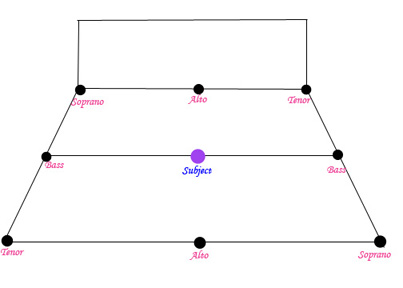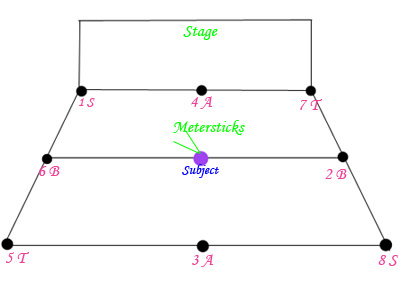Background Info
What Exactly I did
Analysis
Conclusion
Return to Research
The Physics of Sound

The basis of this project is to test the idea that the direction from which a pure tone comes is indistinguishable in an acoustically neutral zone. In order to do this experiment, I got permission from Kim Kroeger to use some members of the Crimsonnaires one morning and see if a not-so-carefully chosen person from the school (some with musical training, some without) would be able to identify where the sound was coming from.
Back to top
Some basic background information surrounding this project comes from Mr. Murray, who told us one day in class that the direction from which a pure tone comes is difficult to identify. This effect is made more distinct when the tone is created in an acoustically neutral zone, such as a choir room or an auditorium. These facts caused me to want to try to replicate this in a building that would allow for acoustics and attempt to reproduce the results in order to prove or disprove the information.
Back to top
For this experiment/project/recreation, I borrowed 8 Crimsonnaires and placed them around the auditorium as shown in Figure One below. There were 2 Sopranos, 2 Altos, 2 Tenors, and 2 Basses. I arranged them so that the two people from each section were directly opposite each other in order to create the best balance of tones. Before I started the project, I selected 4 "subjects" to listen, 2 who had musical training (one from band and one from choir) and two who had no music training. I told them that they would be part of a physics project, and that while they were blindfolded, they would be led into the center of the house of the auditorium and given a meterstick to point in the direction they thought the sound was coming from. I put them in the green room while I explained to the singers that I would be "directing" them, and that they would all start to sing together. After a short time (usually about 2 seconds) I would point directly at one of them and they would continue to sing as the rest of the singers dropped out. I told them that I would point at each one of them, and that I had a very specific order in which I would be pointing at them. The order is demonstrated in Figure Two below.


When everything was set up and all of the singers were in place, I led one subject into the center of the house and sat them in the seats behind the sound board. I handed them a measuring stick and clarified the directions to them, mostly saying that I would be using another meterstick and a protracter in order to measure the number of degrees they were off pointing in the direction of the sound. I let the Crimsonnaires start singing, pointing to the soprano in the front house left to begin with. I then measured the angle between the subject's meterstick, which pointed the direction they thought the sound was coming from, and my own, which pointed directly at the singer in question.
I repeated this process 8 times with each of the 4 subjects, recording the angle each time and pointing at each of the singers with each of the subjects. As mentioned before, I had marked a specific order that I would point to the singers in order to keep things consistant.
Back to top
In analyzing my data, I found it quite interesting how far off some of the people were in predicting the direction of the sound. It seemed that the two people with no musical training were less able to determine which direction the sound was coming from than the two who were musically trained. This could have been due to the fact that the two subjects who were musically trained had more experience determining where a specific sound is coming from. The subject who was in choir told me that it was similar to picking out a voice that was singing a wrong note during class. The fact that the choir member was able to find where the sound was coming from to a matter of 30 degrees when the band person was within 85 and the other two were all over the board shows that it is indeed similar.
Back to top
The data that I collected seems to limitedly prove the theory in question. What the theory fails to account for, however, is that certain people who have been trained musically are better able to determine the direction from which a sound is coming than those who are not trained. However, because I selected only 4 subjects, it is possible that the two musically trained people I selected were an anomally and not the same as anyone else in that regard. It is also possible that the two non-musically trained people that I selected were unable to determine the direction of the sound for some other reason than not being musically trained. However, since there were two people on equal footing with their musical training, it is more likely that people with no musical training simply cannot determine the direction of a pure tone in an acoustically neutral zone.
Were I to do this project over, I would probably find more subjects from each group in order to verify the results that I got this time through. I think that using 8 trials per subject was sufficient for data collection, and that it should be an accurate representation of what each subject was able to do.
All in all, I think this experiement went fairly well, although it could be improved in some ways.
Please don't mark me down too much for being late?
Back to top